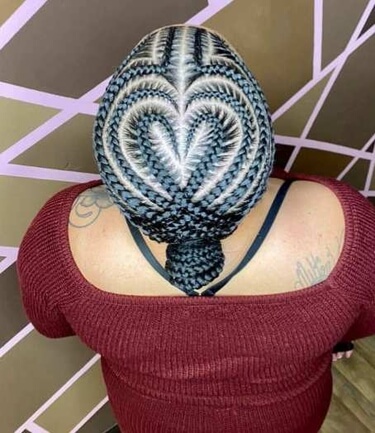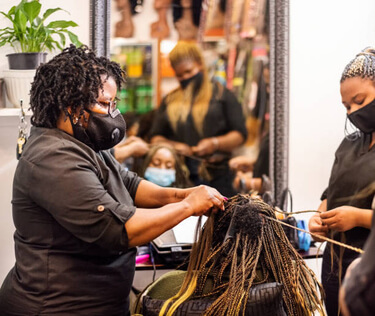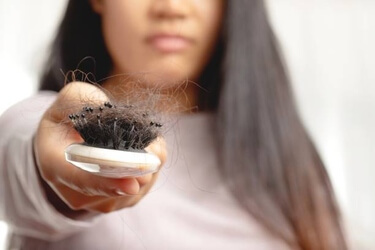Cornrows vs Dreadlocks? Regardless of gender, cornrows and dreadlocks are excellent hairstyles to refresh your look. One is a simple, traditional hairstyle that allows self-expression. The other is a semi-permanent trendy statement.
But how else are these two styles different? Let’s examine what makes each of them unique, from their history to maintenance required.
We will also discuss what to consider when choosing between the two hairstyles. This will help you pick the style that meets your style and preferences. Let’s begin!
What Are Cornrows?
Cornrows are a classic hairstyle where you weave hair strands close to the scalp. Cornrows are created using underhand and upward motions.
Cornrows can range from simple, straight lines to more elaborate and expressive designs. This styling flexibility makes it a favourite for various events and preferences.
History of Cornrows
Cornrows have a rich history that goes back to 3000 BC in Africa. as Stone Age paintings of women wearing cornrows depict.
Though it looks modern, cornrows in Africa served as a way to convey a person’s social position. These included the tribe, age, marital status, occupation, and even religious beliefs.
The hairstyle also has a history beyond Africa. Artwork from Middle Eastern civilisations depicts cornrows as common among male warrior cultures.
Cornrows Styling Procedure
As stated earlier, you create cornrows by braiding hair close to the scalp using upward motions. Below is a simple procedure to braid basic cornrows:
Step 1: First, wash and then detangle your hair while still damp.
Step 2: Then, part your hair into 3–8 sections from front to back. Ensure the sections don’t overlap.
Step 3: Divide each section into 3 strands from front to back.
Step 4: After that, cross the left strand over the middle strand, then cross the right over the middle again.
Step 5: Now repeat step 4 until you reach the nape of the neck. Tie off the completed section with an elastic, then repeat the process for the other sections.
Cornrows aren’t only stunning; they are also easy to braid. In one braiding session, you will save yourself trips to the salon and still turn heads everywhere you go.
Different Styles of Cornrows
Cornrows may have been a girls’ hairstyle back in the day, but that was then. The hairstyle has now evolved into a unisex hairstyle that is rocked by celebrities, business people, office workers, etc.
Below are some stylish designs you can braid for various occasions:
1. Criss-Cross Goddess Braids

Goddess braids are perfect for casual days when you want a low-maintenance hairstyle. They are pretty easy to weave and just as simple to remove
2. Feed-In Braids

Feed-in braids are the definition of a quick, effortless, and gleaming appearance. Using hair extensions adds a natural and flawless touch to the style. Going for a particular look? Consider experimenting with different types and lengths of hair extensions.
3. Cornrow Hearts

Looking to be more creative with your hairstyle? Try incorporating a heart into your look. Cornrow hearts, aka heart braids, have become a beloved and trendy style. Don’t stop at one heart, add multiple to showcase your uniqueness.
4. Triangle Box Braids

Creativity knows no bounds when it comes to cornrows. Take the captivating triangle box braids, for instance. Your hair is carefully partitioned into triangular sections to deliver a fresh and distinctive look.
5. Two Cornrow Braids

Two cornrows is another style that compliments all attires. They are remarkably easy to create and require the least maintenance. Moreover, you can weave them using just your natural hair or with extensions to enhance your looks.
What Are Dreads?
Dreadlocks, also known as dreads, locs/locks, are rope-like strands of hair knotted and matted together to form textured strands. Think Bob Marley.
Dreads were originally a natural hairstyle; that is, they were made using one’s natural hair. Besides, there are dread extensions that you can attach to your hair to avoid waiting periods.
Dreads are quite popular because they are stylish, and you can braid them in different styles. Celebrities rocking dreadlocks has also changed people’s opinion of the hairstyle. Before, people considered dreads to be funky and dirty, among other stereotypes.
History of Dreadlocks
Like cornrows, dreads boast a deep and cultural history that goes back to Ancient Egypt. Various artifacts from the era feature depictions of the hairstyle.
Besides historical significance, dreads also hold religious and cultural significance. Some individuals associate the hairstyle with religion. They believe that Samson, mentioned in the Old Testament, may have had dreadlocks.
Some of the cultures where dreadlocks are deep-rooted include:
- The Maasai in Africa,
- The Ngagpas of Tibet within Tibetan Buddhism,
- The Sadhu of Hinduism
- The Rastafarian movement, among others
Formation Process
Creating locs is a long process that will test your patience, unlike the one-time styling of cornrows. The process might take 8 months or more for the locs to naturally form and mat together.
Below are some step-by-step techniques you can follow to make simple yet stylish locs by yourself.
1. The Interlocking Method
Also known as latch hooking, the interlocking method involves pulling your hair through itself, rotating from the end of the strand to the root of the hair. This style works well for afro-textured hair.
Step 1: Wash your hair with a clarifying shampoo, then let it dry thoroughly.
Step 2: Divide your hair into sections based on the desired loc sizes then secure them with elastic bands.
Step 3: Pick one section, then insert the hatch hook at the tip. Ater that, use the hook to guide the dread through the root of your loc. Repeat the process until you get a tight Y-shaped formation.
2. The Backcombing Method
The backcombing technique involves teasing sections of your hair towards the root and rolling it in the process. The dreadlocks may appear messed up initially but will become neater over time.
Backcombing is suitable for both straight and textured hair, as well as for both long and short hair (as short as 3 inches (7.62 cm)).
Step 1: Begin by washing your hair with a clarifying shampoo, then letting it dry thoroughly.
Step 2: Next, divide your hair into sections based on the desired loc sizes, then secure them with elastic bands.
Step 3: Now gently comb your hair towards the scalp until it stacks up.
Step 4: Then, Palm-roll the dreads to make them neater.
Step 5: Secure the dreads with elastic bands when you’ve achieved the desired look.
3. The Twist and Rip Method
With this method, you have control over your dreadlocks’ number, size, and quality. It involves twisting the hair strands and then gently pulling them apart, resulting in a messy appearance.
Step 1: Start by washing your hair with a clarifying shampoo, then let it dry thoroughly.
Step 2: Next, divide your hair into sections based on the desired loc sizes, creating square bases. Secure each section with an elastic band.
Step 3: Follow that by removing the elastic band from each section, further subdividing them into smaller sections.
Step 4: Now twist the smaller sections while intermittently pulling them apart.
Step 5: Repeat the process for the rest of the sections.
4. The Braiding Method
This is the go-to method for beginners. It’s pretty easy, requires fewer tools, and offers control over your lock sizes. The braiding method is suitable for afro hair.
Step 1: First, wash your hair with shampoo then allow it to dry.
Step 2: Now, divide your hair into sections based on desired locs sizes then secure each with an elastic band.
Step 3: Next, remove the elastic bands and do simple 3-braid twists.
Step 4: Repeat the process for the remaining sections.
Different Dreadlocks Styles
1. Free-Form Locs

As the name suggests, free-form locs develop without any deliberate manipulation. They offer a sense of freedom, allowing you to embrace your natural hair. Besides, they are pretty low-maintenance.
2. Sisterlocks

Sisterlocks are artificial dreads. Unlike regular locs, you weave sisterlocks into your natural hair using a special locing tool.
Sisterlocks are usually thinner (microlocs), making them easily distinguishable from regular locks. The installation can be time-consuming, and they require some maintenance, say every 4–6 weeks.
3. Traditional Locs

Classic dreads involve twisting sections of hair into long strands through methods such as backcombing or palm-rolling. You can style the locs in various ways. You wear them in up buns to let them hang, making them an elegant and timeless choice.
Cornrows vs. Dreads: The Key Differences
Cornrows and dreads are popular hairstyles, each with a rich history and cultural significance. While people love the styles for their appeal, they differ in several aspects.
1. Styling Complexity

Cornrows are pretty easy to braid. You can create simple yet elegant cornrows in one sitting, say 2 to 4 hours. Designer cornrows may take longer but are still less time-consuming compared to dreads.
Dreads, on the other hand, are a little complex. You may need an expert to begin the process, with the initial installation taking 8 or more hours, and that’s just the first stage. To get mature locks, it might take close to 2 years, depending on your hair.
2. Styling Duration

Cornrows are temporary and often regarded as a quick fix that can be undone whenever you feel like it. But that does not mean they aren’t long-lasting. With proper care, you can rock your elegant cornrows for 1 – 8 weeks with minimal intervention.
In contrast, dreads are semi-permanent, meaning they are not easy to unravel. If you decide to keep them, dreads can last for more than 2 years, making it the ideal choice for a personality look.
3. Maintenance Effort

Both styles demand maintenance. Cornrows can be challenging to wash as they can become loose. You may need to avoid certain shampoos and remember to put on a night scarf to prevent the loosening. Wiping the scalps with anti itch liquid or oil will also help.
Here are some tips to ensure your cornrows are well-maintained:
- Minimize friction between your hair and accessories such as hats and beanies.
- Avoid applying thick hair products that would need more washing.
- Adequately moisturize your scalp.
- Don’t keep them for too long without restyling.
As for dreadlocks, you need to begin proper maintenance early on. Avoid washing your locs in the initial stages, and visit your loctician for retwisting sessions. He/she should also recommend when to wash your locs and the hair products to use.
For healthy and durable dreadlocks:
- Wash your locs to remove build-ups and excess oil.
- Ensure your locs are dry.
- Use moisturizing sprays to keep your locs dry (locs are prone to breakage when they are too dry).
- Cover your locs with a night scarf when you sleep.
- Moisturize your scalp.
4. Hair Protection

Both cornrows and dreadlocks offer your natural hair some level of protection. Cornrows shield your hair from damage caused by frequent styling, as well as from harmful hair products commonly used.
Dreads, on the other hand, provide long-term protection. After the formative stage, your hair is shielded from constant manipulation for a long time. Just make sure to avoid frequent unlocking in the early stages.
Which One is Better? Cornrows or Dreads
Choosing between cornrows and dreadlocks depends on your preferences and lifestyle. As you’ve seen above, both can be special in their way.
To make an informed decision, consider the following factors:
1. Your Lifestyle

Cornrows are a good choice for those with changing lifestyles. They are simple to create and undo, allowing you to adapt to various occasions. Additionally, if you want to avoid constant visits to the salon, cornrows are still a perfect choice since they can endure 2–8 weeks before another round of styling.
Dreads, on the other hand, require more commitment, particularly in the formation stage. Besides the full day spent at the loctician during the initial phase, you’ll need to dedicate a few hours every 1–2 weeks for retwisting sessions until a strong foundation is formed.
However, once you are through the formative stage, dreadlocks become one of the most low-maintenance hairstyles to keep.
2. Aesthetic Preferences

Cornrows are very versatile when it comes to styling. Styling your hair into different shapes and patterns is easy. They are the perfect hairstyle for experimentation and self-expression.
Dreads are also versatile in their way. Once locked, you can transform them into a braided style and undo them to revert to their previous state.
Going for a more personalized appearance? Increasing the locs length and volume using artificial locs is a good place to start.
3. Hair Texture & Type

The cornrows hairstyle offers a good chance of protecting your natural hair. They can promote hair growth by preventing excessive pulling and reducing the risk of traction alopecia – a condition caused by wearing tight braids.
Besides, cornrows are highly compatible with various hair types, making them a perfect choice for individuals with different hair lengths and textures.
Similar to other protective hairstyles, dreadlocks can also shield your hair from damage when properly maintained. Ensure your locs are always dry, minimize frequent retwists, invest in healthy hair products and your natural hair will be just fine.
4. Budget & Time Constraints

Cornrows will initially cost you anywhere between $30 and $300 to braid the first time. The cost can however vary depending on factors such as the number of braids, complexity of the design, salon reputation, and location.
Cornrow maintenance should require less time and money compared to the initial braiding. The amount of time and money spent on maintenance also depends on how well you take care of your braids.
The initial cost of creating dreadlocks can cost between $45 to $200 and might go up to $1000 plus in cases where dreadlocks extensions are used. Like cornrows, the prices depend on factors such as location, hair length, density, and the desired style.
Dreads demand more time and money during the initial stages. But, the time and money spent on maintenance reduce as the locs mature, especially if well kept.
Cornrows vs Dreadlocks
If you ask us, there’s no better choice between cornrows and dreadlocks because each is unique in its way. Cornrows are perfect for those who prefer to occasionally change their styles. Dreads are for individuals seeking lasting and distinctive styles.
Ultimately, the decision should align with your personal preferences, needs, and lifestyle. Pick a style and wear it with pride and confidence.






